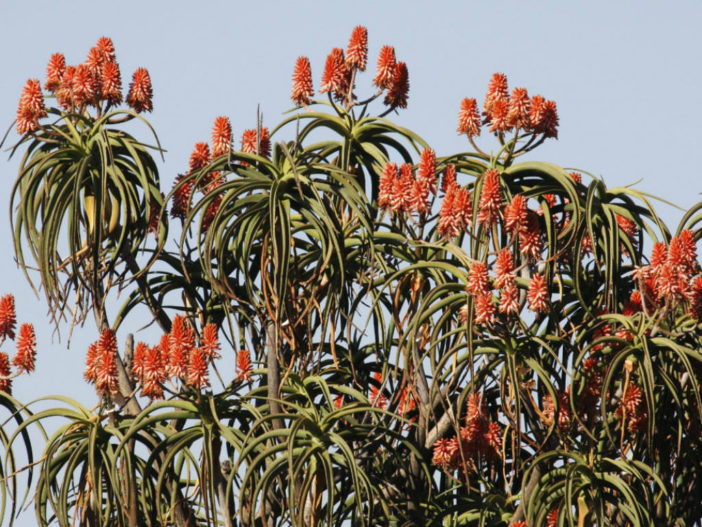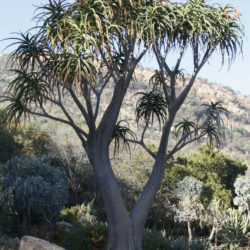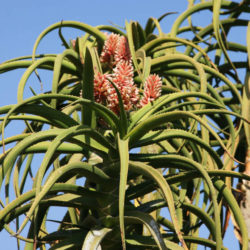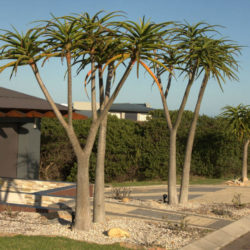Scientific Name
Aloidendron barberae (Dyer) Klopper & Gideon F.Sm.
Common Name(s)
Giant Tree Aloe, Tree Aloe, South African Tree Aloe
Synonym(s)
Aloe bainesii, Aloe bainesii var. barberae, Aloe barberae
Scientific Classification
Family: Asphodelaceae
Subfamily: Asphodeloideae
Genus: Aloe
Etymology
The specific epithet "barberae (BAR-ber-ay) honors the discoverer of the species, Mary Elizabeth Barber (1818-1899), a pioneering British-born amateur scientist in botany, ornithology, and entomology.
Origin
This species is native to South Africa (Eastern Cape, KwaZulu-Natal, and Mpumalanga), Eswatini, and Mozambique. It grows in subtropical coastal forests, ravines, and dry valleys.
Description
Aloidendron barberae, formerly known as Aloe barberae, is a succulent tree branching dichotomously many times from a stout trunk. It is a slow-growing plant that can grow up to 54 feet (18 m) tall, while the trunk can reach up to 16.4 feet (5 m) in height and 10 feet (3 m) in diameter. The leaves are spreading and recurved, arranged in a compact rosette at the end of the branches. They are dull green, lance-shaped, deeply channeled, with firm whitish teeth, measuring up to 3 feet (90 cm) long and 3.6 inches (9 cm) wide.
The inflorescences, one from each rosette, are simple or divided into three side branches with cylindrical, densely flowered racemes. They can reach up to 2 feet (60 cm) in height. The racemes are erect, cylindrical, up to 12 inches (30 cm) long and 4 inches (10 cm) in diameter. The flowers are cylindric-trigonous, vary in color from pale yellow to orange-yellow or salmon-pink, measure up to 1.5 inches (3.7 cm) long and 0.35 inches (0.9 cm) in diameter, and appear in winter. The fruits are brown dehiscent capsules containing pale brown seeds with broad wings. They are ovoid and can reach up to 1.6 inches (4 cm) long and 0.7 inches (1.7 cm) in diameter.

Hardiness
USDA hardiness zones 9b to 11b: from 25 °F (−3.9 °C) to 50 °F (+10 °C).
How to Grow and Care
Aloes are very forgiving plants. However, as with all succulents, Aloe must never be allowed to sit in stagnant water, and the plant should be carefully monitored to watch for signs of overwatering.
These succulents are not particularly fast-growing and will only rarely need repotting. However, in the spring, repot Aloes tipping over their pots or have ceased growing. Use a fast-draining potting mix with one-third sand or pebbles. When repotting a larger plant, dividing the root ball carefully is possible. Some varieties of Aloe will send off offsets that can be potted independently.
Aloe plants need strong, bright light. They can withstand full summer sun once acclimated. In the winter, provide bright light. It prefers warmer temperatures of 70 to 80 °F (21 to 27 °C) but will survive down to 40 °F (4.5 °C). Feed with a succulent fertilizer in the summer only. Suspend feeding in the winter as the plant goes dormant.
Learn more at How to Grow and Care for Aloe.
Links
- Back to genus Aloidendron
- Succupedia: Browse succulents by Scientific Name, Common Name, Genus, Family, USDA Hardiness Zone, Origin, or cacti by Genus
Photo Gallery
Click on a photo to see a larger version.


